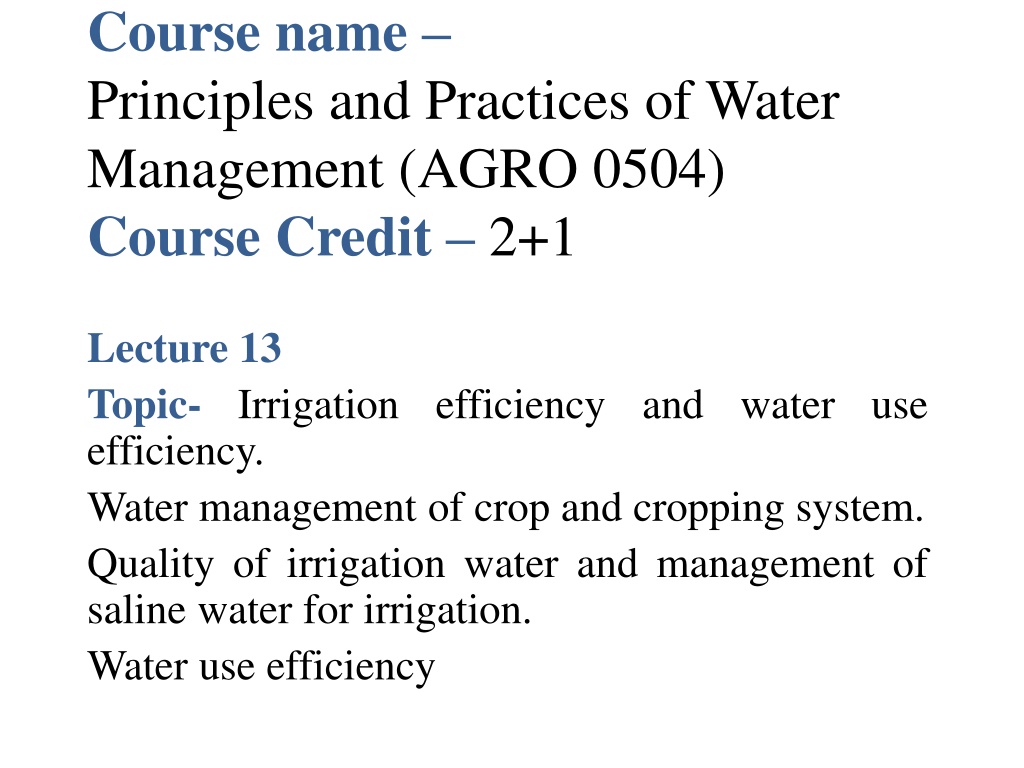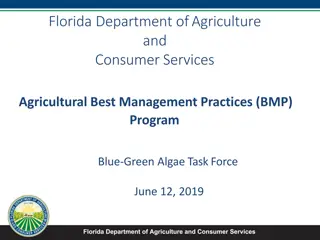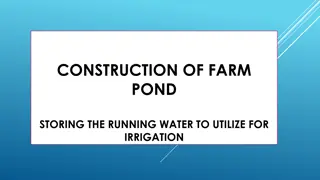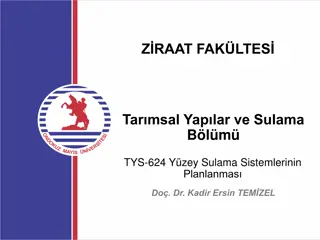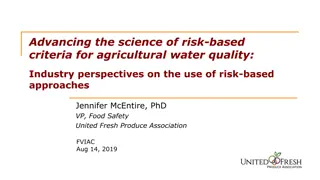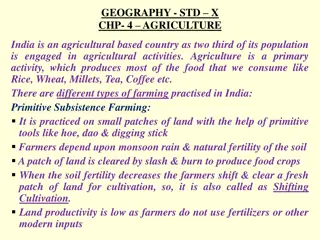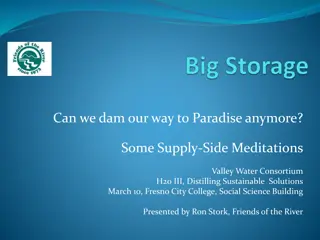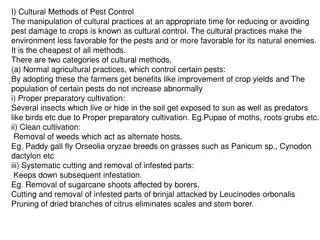Principles and Practices of Water Management in Agricultural Cropping Systems
This course delves into the principles and practices of water management in agricultural cropping systems, focusing on topics such as irrigation efficiency, water use efficiency, crop and cropping system water management, and quality of irrigation water. It explores how assured irrigation water facilities create opportunities for multiple cropping and discusses major cropping systems in different agro-climatic zones of Andhra Pradesh, including rice-based and sugarcane-based systems.
- Water Management
- Agricultural Cropping Systems
- Irrigation Efficiency
- Crop Water Management
- Andhra Pradesh
Download Presentation

Please find below an Image/Link to download the presentation.
The content on the website is provided AS IS for your information and personal use only. It may not be sold, licensed, or shared on other websites without obtaining consent from the author. Download presentation by click this link. If you encounter any issues during the download, it is possible that the publisher has removed the file from their server.
E N D
Presentation Transcript
Course name Principles and Practices of Water Management (AGRO 0504) Course Credit 2+1 Lecture 13 Topic- Irrigation efficiency and water use efficiency. Water management of crop and cropping system. Quality of irrigation water and management of saline water for irrigation. Water use efficiency
Water management of the crops and cropping systems; quality of irrigation water and management of saline water for irrigation; water use efficiency
UNIT IV Water management of the crops and cropping systems Assured irrigation water facilities provide opportunities for multiple cropping (intercropping, sequential cropping, relay cropping etc). Major sources of irrigation include canal irrigation, tank-fed and well irrigation. Depending on the water availability period, 1,2 seasons or all the year round the number of crops raised per year on a given piece of land is determined. Thus, the cropping intensity in irrigated agriculture ranges from 200 to 400%. Major crops in different agro-climatic zones vary greatly, depending on their adaptability and irrigation water availability. Crops that follow the main crops in sequence also differ from region to region. Major rice, sugarcane and groundnut based cropping systems in Andhra Pradesh are as follows:
1 Rice based cropping systems The profitable rice based cropping systems followed in different agro-climatic zones of Andhra Pradesh are as follows: a) North Coastal zone Rice Greengram/Blackgram in irrigated wet lands Rice Maize in irrigated uplands b) Krishna Godavari zone Rice Rice Rice Maize Rice Groundnut Rice Greengram/Blackgram c) Southern zone Rice Rice Rice Sunflower Rice Groundnut Rice Finger millet Groundnut d) Northern Telangana zone Rice Rice Rice Groundnut Rice Maize Rice Sunflower e) High Altitude Tribal zone Rice Vegetables Rice Horsegram
2 Sugarcane based cropping systems The profitable sugarcane based cropping systems followed in different agro- climatic zones of Andhra Pradesh are as follows: 2.1 Profitable cropping systems a) North coastal districts Sugarcane Sugarcane Sesame Paddy Sugarcane Sugarcane Maize paddy b) Southern zone Sugarcane Sugarcane Groundnut c) All zones Sugarcane Sugarcane Paddy d) Godavari zone Sugarcane Sugarcane Greengram/Blackgram e) Krishna zone Sugarcane Sugarcane Turmeric f) Nizamabad zone Sugarcane Sugarcane Sunflower Soyabean Sugarcane Sugarcane
Profitable intercropping systems a) Western part of Chittoor Sugarcane + Rajmash sugarcane + Tomato sugarcane + Bhendi b) Nellore Sugarcane + Watermelon c) Medak Sugarcane + Potato Sugarcane + Bengalgram d) North-coastal districts Sugarcane + Blackgram Sugarcane + Blackgram Groundnut based cropping systems The profitable groundnut based cropping systems followed in different agro-climatic zones of Andhra Pradesh are as follows: a) North coastal districts Groundnut + Redgram Groundnut Jowar Groundnut Vegatables Groundnut Rice Groundnut Horsegram
b) Krishna Godavari Zone Groundnut Bhendi Groundnut Chillies Groundnut Redgram c) Southern zone Sugarcane Sugarcane Groundnut Groundnut Groundnut Groundnut Sunflower / Jowar / Redgram Groundnut Castor d) Scarce Rainfall zone Groundnut Fodder Jowar Groundnut Vegetables / Watermelon e) North Telangana zone Rice Groundnut Cotton Groundnut Groundnut Horsegram Groundnut + Redgram Groundnut Jowar / Safflower f) High Altitude Tribal zone Groundnut Minor millets Groundnut Niger
Water use efficiency water use efficiency is a ratio between marketable crop yield and water used by the crop in evapotranspiration. Y WUE (kg/ha-mm)= Etc Where, WUE = Water use efficiency in kg/ha-mm Y = Marketable crop yield in kg/ha ETc = Crop evapotranspiration in mm
Water Use Efficiency of Crops CROP Water requirement (mm) Grain yield (kg/ha) WUE (kg/ha-mm) Rice 1200 4500 3.7 Sorghum 500 4500 9.0 Pearl millet 500 4000 8.0 Maize 625 5000 8.0 Groundnut 506 4616 9.2 Wheat 280 3534 12.6 Finger millet 310 4137 13.7
Factors affecting water use efficiency The factors influencing water use efficiency can be classified as follows:
Irrigation efficiency indicates how efficiently the available water supply is being used, based on different methods of evaluation. The objective of efficiency concept is to show where improvements can be made, which will result in more efficient irrigation. Various efficiency terms are : 1. Water conveyance efficiency This term is used to measure the efficiency of water conveyance systems associated with the canal network, water courses and field channels. It is also applicable where the water is conveyed in channels from the well to the individual fields. It is expressed as follows: Wd Ec = ---------- x 100 Wf Where, Ec = Water conveyance efficiency, per cent Wd = Water delivered to the irrigated plot (at the field supply channel) Wf = Water diverted from the source 2. Water application efficiency After the water reaches the field supply channel, it is important to apply the water as efficiently as possible. A measure of how efficiently this is done is the water application efficiency, expressed as follows : Ws Ea = ---------- x 100 Wd Where, Ea = Water application efficiency, per cent Ws = Water stored in the root zone of the crop Wd = Water diverted to the field (at the supply channel)
3. Water storage efficiency The water storage efficiency refers how completely the water needed prior to irrigation has been stored in the root zone during irrigation. It is expressed as : Ws Es = ---------- x 100 Wn Where, Es = Water storage efficiency, per cent Ws = Water stored in root zone during irrigation Wn = Water needed in root zone prior to irrigation 4. Water distribution efficiency Water distribution efficiency indicates the extent to which water is uniformly distributed along the run. It is expressed as : y Ed = 100 1 - ------- d Where, Ed = Water distribution efficiency, per cent d = Average depth of water stored along the run during the irrigation y = Average numerical deviation from d
5. Water use efficiency It refers to the amount of marketable end product obtained per unit of water used by the crop. Total economic yield (kg ha-1) WUE (kg ha-1 mm-1) = ---------------------------------------------------- Total consumptive use (mm) (i) Crop water use efficiency: It is the ratio of crop yield (y) to the amount of water depleted by the crop in the process of evapotranspiration (ET). Y Crop water use efficiency = ------------- ET (ii) Field water use efficiency: It is the ratio of crop yield (y) to the total amount of water used in the field (WR) Y Field water use efficiency =----------------- WR 6. Project efficiency Project efficiency indicates the effective use of the irrigation water source in crop production. It is the percentage of irrigation water that is stored in the soil and is available for consumptive use by crops. When the delivered water is measured at the farm head gate or well, it is called farm irrigation efficiency, when measured in the field, it is designated as field irrigation efficiency, and when measured at the point of diversion from the canal or the main source of supply it may be called project efficiency. 7. Ope rational efficiency Operational efficiency is the ratio of actual project efficiency compared to the operational efficiency of an ideally designed and managed system using the same irrigation method and facilities. Low operational efficiency indicates management or system design problems, or both.
8. Economic (irrigation) efficiency Economic efficiency is the ratio of the total production (net or gross profit) attained with the operating irrigation system, compared to the total production expected under ideal conditions. This parameter is a measure of the overall efficiency, because it relates the final output to input. Significance of irrigation efficiencies A low value of any of the irrigation efficiencies in general implies that the land, water and the crops are not being managed properly. A low conveyance efficiency implies that much of the water released from the source is lost in transit form source to the field. A low application efficiency means wastage of water in the form of deep percolation or runoff losses. A poor storage efficiency means water has been applied inadequately. A poor distribution efficiency results due to uneven land sur face. There are low patches where water will penetrate more and there are high patches where water cannot reach. A low water use efficiency also results due to over application of water or inability of the crops to utilize the applied water due to poor vegetative growth or adverse chemical properties of root zone soil and water. The net effects of poor irrigation efficiencies are crop loss and wastage of water and nutrients. Wf (i) Water conveyance efficiency, Ec = ------------ x 100 Wd
Ws (ii) Water application efficiency, Ea = -------- x 100 Wd Ws (iii) Water storage efficiency, Es = -------------- x 100 Wn iv) Water distribution efficiency, Ed = 100 1 - ---------- d y
Quality of irrigation water and management of saline water for irrigation Good quality irrigation water is essential to maintain the soil crop productivity Poor quality water damage both In india, about 3.58 mha and 5.50 mha are alkali and saline soil receptively Page 400 dk mujumdar ..
